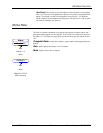
TROUBLESHOOTING
VORTEX EF2241 Reference Manual 42 Technical Support: 800.932.2774
Nonlinear distortion causes a degradation or divergence of the AEC’s internal model
of the room acoustics. In this situation, the EF2241 cannot effectively cancel room
echoes and a substantial amount of echo may be heard by the remote party.
Excessive microphone amplification also increases room gain (See “Excessive Room
Gain” on page 40.). You can check for excessive microphone amplification by
observing the front panel L
EVEL INDICATOR during a normal conference. The first
yellow LED should illuminate frequently. If the second yellow LED is illuminated
constantly during normal speech or if the red LED illuminates or even flickers, reduce
the microphone input level.
Insufficient
Microphone
Amplification
Grossly insufficient microphone gain degrades EF2241 performance and weakens the
out-bound speech power level. This has the effect of reducing the signal-to-noise
ratio of the microphone signal, which is analogous to raising the background noise
level in the room. Because this noise is uncorrelated with the echoes within the room,
the EF2241’s ability to adapt and cancel echoes will be less than optimal.
A second effect of insufficient microphone gain is that the power of the microphone
input signal may be substantially lower than that of the remote input signal. This
reduces the ability of the decision logic to determine whether the AEC should be in
transmit, receive, or double-talk mode. This effect may reduce the effectiveness of
the EF2241 in canceling echoes.
You can check for insufficient microphone amplification by observing the front panel
L
EVEL INDICATOR during normal conferencing conversation. The first yellow LED
should illuminate frequently. If the L
EVEL INDICATOR never illuminates beyond one
or two green LEDs during normal speech, increase the microphone’s input level.
Nonlinearity Overdriving the loudspeaker or inserting a dynamics processor before the EF2241
may distort the signal that the microphones see causing ineffective AEC operation.
The EF2241 relies on the linearity of the acoustic feedback path — D/A, amplifier,
loudspeaker, microphone, and A/D — to cancel acoustic echoes. If you overdrive the
loudspeaker or insert a dynamics processor before the echo canceller, the acoustic
reflections picked up by the microphone do not match the signal fed to the loud-
speaker. They are distorted copies of this signal. The EF2241 cannot effectively can-
cel this distorted signal.
Note. Before you readjust the microphone input levels, check to
make sure you are looking at the correct channel on the L
EVEL
I
NDICATOR.
Note. If you adjust the MIC/LINE INPUT level, you will affect the
room gain. Check to make sure that the room gain limit is not
exceeded. See “Verify Room Gain” on page 14.
Note. Before you readjust the microphone input levels, check to
make sure you are looking at the correct channel on the L
EVEL
I
NDICATOR.
Note. If you adjust the MIC/LINE INPUT level, you will affect the
room gain. Check to make sure that the room gain limit is not
exceeded. See “Room Gain” on page 39.


















